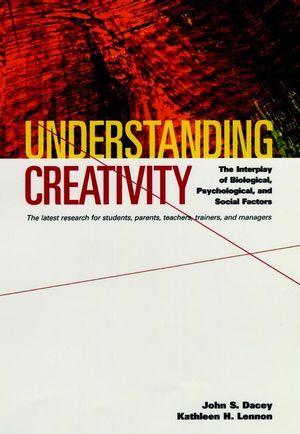Understanding Creativity: The Interplay of Biological, Psychological, and Social FactorsISBN: 978-0-7879-4032-4
Hardcover
310 pages
November 1998, Jossey-Bass
 This is a Print-on-Demand title. It will be printed specifically to fill your order. Please allow an additional 10-15 days delivery time. The book is not returnable.
|
||||||
This book combines the wonder and awe of human creativity with the
complexity of its study. The authors advance the ?biopsychosocial'
perspective as a model of the creative process. . . . This new
perspective promises to further our understanding of the
?intricacies of the creative mind.' In the process of studying this
book, readers may increase the probability of enhancing their own
creativity.
--Richard E. Ripple, professor, educational and developmental psychology, Cornell University
In Understanding Creativity John S. Dacey and Kathleen H. Lennon offer a thorough examination of the three factors--biological, psychological, and social--that contribute to the creative process. This compelling book explores a breadth of topics on creativity including: how creative people operate as successful and imaginative problem solvers, the essential role self-control plays in realizing creative potential, and the most current discoveries about how the brain works on the neuronal and chemical levels. Most important, the book presents an innovative model that integrates the biological, psychological, and social elements and reflects the most significant advances in current creativity research.
Understanding Creativity beautifully reveals the intricacies of the creative process and advances an innovative new view that can help anyone interested in the creative process to not only better understand it?but to enhance it.
Table of Contents
Part One: Introduction
1. The Many Components of Creativity
2. A Brief History of the Concept of Creativity
Part Two: Social Factors
3. The Role of the Family
4. The Role of the Social Context
Part Three: Psychological Factors
5. Ten Traits that Contribute to the Creative Personality
6. The Special Contribution of Self-Control
7. The Formation of Creative Personality Traits
8. Creative Cognitive Processes
9. Creative Problem Solving
Part Four: Biological Factors
10. The Brain at the Cellular Level
11. The Hemispheres of the Brain
Part Five: Integration
12. A New Biopsychosocial Explanation of Creativity
--Richard E. Ripple, professor, educational and developmental psychology, Cornell University
In Understanding Creativity John S. Dacey and Kathleen H. Lennon offer a thorough examination of the three factors--biological, psychological, and social--that contribute to the creative process. This compelling book explores a breadth of topics on creativity including: how creative people operate as successful and imaginative problem solvers, the essential role self-control plays in realizing creative potential, and the most current discoveries about how the brain works on the neuronal and chemical levels. Most important, the book presents an innovative model that integrates the biological, psychological, and social elements and reflects the most significant advances in current creativity research.
Understanding Creativity beautifully reveals the intricacies of the creative process and advances an innovative new view that can help anyone interested in the creative process to not only better understand it?but to enhance it.
Table of Contents
Part One: Introduction
1. The Many Components of Creativity
2. A Brief History of the Concept of Creativity
Part Two: Social Factors
3. The Role of the Family
4. The Role of the Social Context
Part Three: Psychological Factors
5. Ten Traits that Contribute to the Creative Personality
6. The Special Contribution of Self-Control
7. The Formation of Creative Personality Traits
8. Creative Cognitive Processes
9. Creative Problem Solving
Part Four: Biological Factors
10. The Brain at the Cellular Level
11. The Hemispheres of the Brain
Part Five: Integration
12. A New Biopsychosocial Explanation of Creativity



